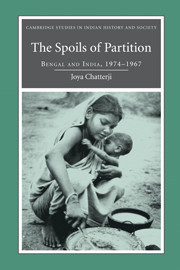Book contents
- Frontmatter
- Contents
- List of maps and illustration
- List of tables
- List of abbreviations
- Glossary
- Preface and acknowledgements
- Introduction
- Part I Hopes and fears
- Part II The Bengal diaspora
- Part III The politics of a partitioned state
- 5 Political reconstruction and change: Congress government and politics, 1947–1967
- 6 The revenge of the periphery: the rise of the opposition in West Bengal
- Conclusion
- Appendix
- Bibliography
- Index
5 - Political reconstruction and change: Congress government and politics, 1947–1967
Published online by Cambridge University Press: 25 June 2009
- Frontmatter
- Contents
- List of maps and illustration
- List of tables
- List of abbreviations
- Glossary
- Preface and acknowledgements
- Introduction
- Part I Hopes and fears
- Part II The Bengal diaspora
- Part III The politics of a partitioned state
- 5 Political reconstruction and change: Congress government and politics, 1947–1967
- 6 The revenge of the periphery: the rise of the opposition in West Bengal
- Conclusion
- Appendix
- Bibliography
- Index
Summary
The demand by Bengal's Hindus for a province inside India in which they would be the majority was intended to lead them securely through the upheavals of partition to a prosperous future. The borders of the province were designed to give it a population upon whose support the leadership could depend. Smaller and poorer after its vivisection, West Bengal, they believed, would become a stable and cohesive polity, part of a larger union in which its special relationship with the centre would compensate for the losses that partition entailed.
After Congress took office in the new state in August 1947, it soon became clear that these plans were going badly wrong. Partition transformed Bengal's political landscape. Having lost two-thirds of its territory to Pakistan, West Bengal was left with only 89 of the 250 constituencies in the Assembly of undivided Bengal. This upset all the old balances and changed the standing of every political party in the new state, often in quite unintended ways. In general, partition tended to strengthen those factions and groups which had been active in the territory which now constituted West Bengal, whereas those with bases mainly in eastern Bengal, not surprisingly, became weaker. Cast adrift from their local moorings, parties once influential in the east had to regroup and find a role for themselves in the west.
- Type
- Chapter
- Information
- The Spoils of PartitionBengal and India, 1947–1967, pp. 211 - 259Publisher: Cambridge University PressPrint publication year: 2007

